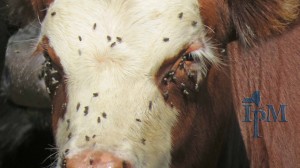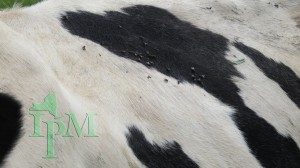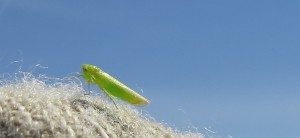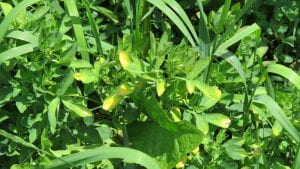Volume 18, Number 10
Contents
View from the Field
Potato Leafhopper (Empoasca fabae)
Potato Leafhopper (PLH) populations are exploding. It is very important to check fields now, before damage occurs. The PLH nymphs are currently in fields. These do more damage than the adults. New seedings are more sensitive to potato leafhopper damage than established stands, and when a field has the added stress of drought it will make the damage worse. Make sure to get out and check your fields NOW! See the article below on more detailed information on potato leafhopper in alfalfa.
We have a training video on IPM for Potato Leafhopper in Alfalfa (8 minutes long). The video helps you understand how to monitor and determine thresholds for potato leafhopper. It also has IPM methods of control of potato leafhopper including harvesting early, planting resistant cultivars and insecticides. IPM For Potato Leafhopper in Alfalfa
Cattle Flies
Flies on cattle are increasing very quickly. This last week I counted an average of 20 stable flies/ cow on pasture, which is double the action threshold. These are biting flies that feed on the legs of the cattle. When cattle start stomping their legs it is a very good indication that the flies are really starting to cause pain and are annoying the animals.
Stable Flies on Legs
Face flies were also over the average of 10 flies per animal threshold. Face flies are not a biting fly but do transmit pink eye and thelazia eyeworm. Face flies an annoyance feeding the animal secretion around the eyes and other places on the cattle.
Horn flies are increasing on cattle. As the summer heats up so will horn flies. Horn flies are biting flies and each fly can take 20 blood meals a day. The threshold for horn flies are 50/side on dairy and 200/side on beef. They are about ½ the size of houseflies. They are found on the back and belly of the cattle.
Potato Leafhopper in Alfalfa
Ken Wise and Jaime Cummings NYS IPM
Across the state, there are many reports of potato leafhopper (PLH) approaching threshold in alfalfa. It is important protect your alfalfa quality by knowing what to do and how to determine if a field has a problem.
This insect pest does not over-winter in the Northeast. Adult PLHs migrate on weather from south and south-west part of the county each year. This year we have had a lot of storms and weather fronts. Many field consultants are reporting finding many numerous adult PLHs in alfalfa fields.
This lime green, slender 1/8 inch long insect can move from plant to plant laying 2-3 eggs per day. Bright yellow-green nymphs hatch from the eggs in search of plant juices.
Adults alone seldom reach threshold (and they already have this year), but the combination of the nymphs and the adult can really cause significant damage to the forage. Both the nymphs and adults have piercing-sucking moth parts. As they suck the sugary phloem juices from the plant, they replace it with their toxic saliva.
Large infestations of potato leafhopper in alfalfa can reduce the plant crude protein by 5% and yield by a ½ ton per acre per cutting. If you see V-shaped yellowing on the tips of the leaves you have a good chance that potato leafhopper has been in your alfalfa. This weakens the plant and it will have slower re-growth after harvest and increased chance of winter kill.
Field Yellowing from Potato Leafhopper
It is TIME TO SCOUT YOUR FIELDS! Use a 15-inch diameter sweep net to determine if a field is at threshold.
You will want to scout from now until late August. Use the potato leafhopper sequential sampling plan to determine if an infestation requires management or not. The first thing to do is determine the height of your alfalfa. Smaller plants are more vulnerable to potato leafhopper; thus there are different action thresholds for different heights of alfalfa. The second thing you will need to know is how to sample for potato leafhopper.
A sample consists of a set of 10 sweeps of the net. A sweep is one pass in front of you as you walk through the alfalfa. The return swing is counted as another sweep. (VIDEO) Since sequential sampling reduces the number of samples that taken, it reduces the time in each field and tells you whether to treat (management action) or not treat (no management action). Sequential sampling is particularly helpful in minimizing time required to make a management decision in situations where PLH populations are very high or very low. Use the following chart to determine potato leafhopper infestation levels.
Write down the number of potato leafhoppers for each sample taken on the card. Add each sample to the next, keeping a running total of potato leafhoppers. You will need to take at least 3 samples using the sequential sampling method. On the sequential sampling card “N” is defined as no treatment (no management) needed at this time and “T” is defined as treatment (management) needed within in a week. If the sample is smaller than the “N” number stop and scout 7 days later. If the number of leafhoppers is larger than the “T” number then management action needs to be taken within a week. If the number of potato leafhoppers fall between “N” and “T” then continue and take the next sample till a decision can be determined. A guide with a printable version of the sequential sampling chart can be found at: http://www.nysipm.cornell.edu/publications/plh.pdf
Now you need to know what to do if an infestation reaches a management action level. The good news is that you have three good options for controlling an infestation of potato leafhoppers in New York alfalfa.
Option 1: Early Harvest
You can harvest the alfalfa early to control PLH if the field is within a week to ten days of a scheduled harvest. By harvesting the alfalfa early, you’ll prevent potato leafhopper from reaching infestation levels that can cause yield and quality loss to the forage. Make sure that the whole field is harvested at the same time. If a field is not clean harvested then the alfalfa that has not been cut will serve as a refuge for PLH that can re-infest; thus severely damaging alfalfa re-growth.
Option 2: Use an Insecticide
To protect yield and health of new seedings and established alfalfa, insecticide control may be warranted when an infested field is not within a week of harvest. For selection of an insecticide, consult the current issue of Cornell Guide for Integrated Field Crop Management. Remember to read the label and be aware of blooms, bees and the days until harvest restrictions.
Option 3: Plant Potato Leafhopper Resistant Alfalfa
A third option for control is planting PLH-resistant alfalfa. Obviously, it is a little late for this season’s crop but something to consider for future seedings. Research has shown that potato leafhopper resistant alfalfa is consistently higher in quality than susceptible alfalfa varieties with or without potato leafhopper pressure. PLH-resistant variety yields are comparable and generally better than susceptible varieties when PLH are present. A bonus benefit is that currently available alfalfa varieties with PLH resistance have come down in price over the past several years.
PLH DAMAGED ALFALFA NOTE: If you have standing alfalfa with potato leafhopper yellowing across the field, it is best to clip off the alfalfa instead of treating it, and then monitor the regrowth. The reason is that the quality of the PLH damaged forage is going to be poor, at best, and you will get a better quality forage if you protect the regrowth.
For more information check our on-line IPM video: Time to Scout for Potato Leafhopper in Alfalfa
NYS Western Bean Cutworm Report for Field Corn 2019
The 2019 Western Bean Cutworm (WBC) Monitoring program is underway and WBC moth collections have begun. We have a total of 85 traps statewide monitoring western bean cutworm this year. Western Bean Cutworm (WBC) is an emerging pest in NY with the potential to cause substantial damage to corn, Zea mays and beans, Phaseolus vulgaris. WBC is native to North America and has historically been a pest of corn and dry beans in the high plains region of the western US. WBC larvae feed on developing corn kernels, bean pods and seeds. Larval feeding damage causes direct yield losses and can increase subsequent risk of ear mold issues including infection by mycotoxin producing fungi.
WBC moths were first confirmed in Pennsylvania and western New York in 2009, one year after they had been detected in Ontario, Canada. Extensive monitoring during 2010 – 2017 has determined that WBC moths are well distributed across these areas and have expanded their range into Quebec and parts of Northeast.
NY WBC populations have increased annually since 2010 as indicated by the average and maximum range in number of WBC moths captured per location (Table 1).
New York Western Bean Cutworm 2010 – 2018 Collection Data Summary*
| 2010 | 2011 | 2012 | 2013 | 2014 | 2015 | 2016 | 2017 | 2018 | |
| No. Counties | 29 | 37 | 44 | 39 | 41 | 39 | 40 | 40 | 45 |
| No. Traps | 54 | 67 | 88 | 89 | 96 | 91 | 101 | 101 | 118 |
| Avg. No. WBC / Trap | 13 | 23 | 42 | 66 | 117 | 266 | 193 | 361 | 333 |
| Range in Totals | 0 – 99 | 0 – 165 | 0 – 344 | 0 – 853 | 0 – 1019 | 0 – 1688 | 0 – 1662 | 0-2464 | 0-2964 |
| Peak Flight | 2-Aug | 2-Aug | 25-Jul | 21-28-Jul | 3-Aug | 2-Aug | 31-Jul | 8-Aug | 1-Aug |
*Data compiled from WBC trap catch information provided by field corn, sweet corn, and dry bean monitoring networks across NY.
Western Bean Cutworm trap location and accumulated moth capture for 2018.
To keep watch on WBC populations and help determine this season’s risk of potential impact WBC pheromone traps are again being monitored across the state by a dedicated network of cooperative extension, agricultural consultant and producer volunteers. WBC trap deployment began in June. WBC numbers are beginning to trickle in indicating moth emergence has begun. Peak WBC moth flight activity is anticipated towards the end of July or early August.
Western bean cutworm updates for sweet corn and dry beans will be available at this blog throughout the season and the NYS IPM Sweet Corn Pheromone Trap Network Report.
Clipboard Checklist
Keith Waldron, NYS IPM
General
*Walk fields to check general field condition, weed issues
*Watch for crop maturity, stand assessments, weed escapes, nutrient deficiencies, lodging issues
Alfalfa:
*Evaluate established legume stands for approximate days until harvest
*Monitor potato leafhopper, foliar, systemic and crown rot diseases.
*Monitor new seedings for potato leafhopper, pythium blight, phytopthora root rot.
Small Grains:
*Monitor spring small grains for signs of Fusarium Head Blight, foliar diseases
*Monitor grain fields for growth stage, disease and lodging issues, grain maturity, harvest timing
*Record diseases present, location and types of weed escapes
Corn:
*Monitor for mid-season corn pests including European corn borer, corn rootworm, western bean cutworm, slugs, foliar diseases such as northern corn leaf blight and gray leaf spot, weed issues, nutrient deficiencies, vertebrate damage.
Soybeans:
*Monitor for crop growth stage, soybean aphid, defoliators, foliar diseases, white mold, weed issues, vertebrate damage
Pastures:
*Check water sources, mend fences as needed.
*Check crop growth, clip pastures between grazing as needed
*Monitor for invasive species, plants harmful to livestock
*Review/Plan rotations
Storage:
* Check stored grain bins for temperature, moisture and signs of mold and insects. Aerate, core, transfer grain or treat as necessary
* Clean and disinfect empty storage bins in preparation for grain harvest
*Check forage allocation and anticipate feed program adjustments as forages from previous year are used up
*Mow around storage bins and facility to minimize pest hiding places
Dairy Cattle Barn Fly Management:
*Monitor animals and barn area for house fly, stable fly and other pest management needs including presence of rodents and birds.
*Check facilities for favorable fly breeding conditions: (organic matter + moisture): leaks in watering systems, roof gutters for leaks and potential overspill, drainage,
*Sanitation, sanitation, sanitation – clean animal resting areas, feed troughs, minimize source of moist organic matter i.e. fly breeding areas in barn and in adjacent animal loafing yard
* Continue fly monitoring: install “3X5″ index card fly speck monitoring cards throughout barn
*Use, replenish, replace fly management materials: sticky fly tapes/ribbons, insecticide baits, natural enemies (parasitoids), fly population monitoring (3 x 5) spot cards
*Consider purchase and release of Muscidifurax raptor and/or M. raptorellus natural enemies of house and stable fly pupae.
Dairy Cattle on Pasture:
*Monitor animals for presence of face flies, horn flies and stable flies. Action guidelines: face flies (average 10 per animal face), horn flies (average 50 / dairy per animal side, 200 / beef cattle per animal side), stable flies average 10 per animal (all four legs)
*Check feed bunk / water source locations for signs of stable fly breeding (moist undisturbed organic matter – spilled feed, round bales, etc.), minimize source of moist organic matter i.e. fly breeding areas in barn and in adjacent animal exercise yard.
*Check pasture for forage quality / quantity, rotate as appropriate
*Check pasture for vegetation poisonous to livestock
*Consider use of pasture fly traps to help reduce deer, horse and stable fly populations









